- Yarrow’s Medicinal Properties
- Benefits of Yarrow
- Preparation and Usage
- Side Effects and Precautions
- Conclusion
- Benefits of Growing Yarrow
- 1. Medicinal Uses
- 2. Natural Pest Control
- 3. Soil Improvement
- 4. Attractive to Pollinators
- 5. Drought Tolerant
- 6. Cut Flower and Craft Material
- How to Plant and Care for Yarrow
- Planting Yarrow
- Caring for Yarrow
- Propagating Yarrow
- Common Yarrow Species
- 1. Achillea millefolium
- 2. Achillea filipendulina
- 3. Achillea ptarmica
- 4. Achillea tomentosa
- 5. Achillea nobilis
- 6. Achillea clavennae
- 7. Achillea ptarmicoides
- 8. Achillea ageratum
- 9. Achillea borealis
- 10. Achillea asplenifolia
- Popular Yarrow Varieties
- 1. Achillea millefolium ‘Cerise Queen’
- 2. Achillea millefolium ‘Paprika’
- 3. Achillea millefolium ‘Moonshine’
- 4. Achillea millefolium ‘Strawberry Seduction’
- 5. Achillea millefolium ‘Coronation Gold’
- Harvesting and Using Yarrow
- Harvesting Yarrow
- Drying Yarrow
- Using Yarrow
- Tips for Growing Yarrow Successfully
- 1. Choose the Right Location
- 2. Prepare the Soil
- 3. Planting
- 4. Watering
- 5. Mulching
- 6. Pruning
- 7. Pest and Disease Control
- Questions and Answers:
- What are the properties of yarrow?
- How do I plant yarrow?
- What care does yarrow require?
- What are the different species and varieties of yarrow?
- Can yarrow be used for medicinal purposes?
- How do I prune yarrow?
- Does yarrow attract pollinators?
- Videos: Benefits of Yarrow- Medicinal Uses of Common Yarrow
Yarrow, also known as Achillea, is a perennial herbaceous plant native to temperate regions of the Northern Hemisphere. It is known for its beautiful clusters of small, daisy-like flowers and its medicinal properties. Yarrow has been used for centuries in traditional medicine to treat various ailments, including digestive issues, fever, and wounds.
Yarrow is easy to grow and care for, making it a popular choice for gardens and landscapes. It can thrive in a wide range of soil conditions, from sandy to clayey, and prefers full sun. Yarrow is a hardy plant that can withstand drought and is resistant to most pests and diseases. It is also a favorite of butterflies, attracting them with its nectar-rich flowers.
There are several species and varieties of yarrow, each with its own unique characteristics. Common species include Achillea millefolium, Achillea filipendulina, and Achillea ptarmica. Some popular varieties include ‘Moonshine’, ‘Cerise Queen’, and ‘Paprika’. Each variety offers a different flower color, size, and shape, allowing for endless possibilities in garden design.
Whether you’re a seasoned gardener or a beginner, this ultimate guide to yarrow will provide you with all the information you need to successfully grow, care for, and enjoy this versatile plant. From its medicinal properties to its wide range of species and varieties, yarrow is a must-have addition to any garden. So grab your gardening tools and get ready to plant some yarrow!
Yarrow’s Medicinal Properties
Yarrow, also known as Achillea millefolium, is a herbal plant that has been used for its medicinal properties for centuries. This plant is native to the Northern Hemisphere and is known for its beautiful white or pink flowers.
Benefits of Yarrow
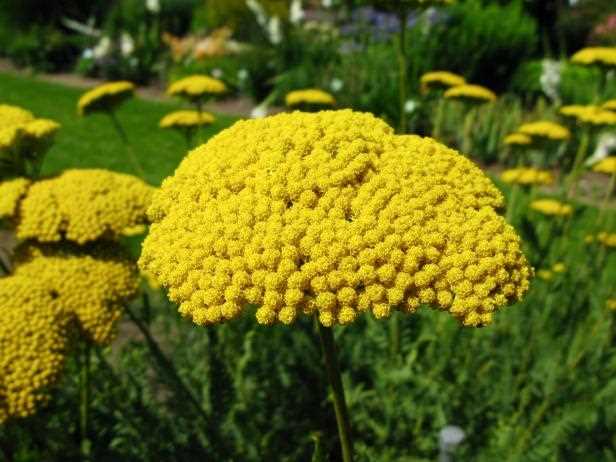
Yarrow offers a wide range of health benefits and can be used for various purposes. Some of its medicinal properties include:
- Anti-inflammatory: Yarrow has anti-inflammatory properties that can help reduce inflammation in the body. It can be used topically to treat wounds, cuts, and bruises.
- Pain relief: Yarrow has analgesic properties, which means it can help alleviate pain. It can be used as a natural remedy for headaches, migraines, and menstrual cramps.
- Antibacterial and antifungal: Yarrow has antibacterial and antifungal properties, which can help fight against various infections. It can be used to treat skin infections, respiratory infections, and urinary tract infections.
- Digestive aid: Yarrow can help improve digestion and relieve digestive issues such as bloating, indigestion, and diarrhea.
- Immune booster: Yarrow has immune-boosting properties and can help strengthen the immune system. It can be used to prevent and treat common colds, flu, and other respiratory infections.
Preparation and Usage
Yarrow can be used in various forms, including teas, tinctures, and essential oils. Here are some common methods of preparation and usage:
- Tea: To make yarrow tea, steep dried yarrow leaves and flowers in hot water for about 10-15 minutes. The tea can be consumed up to 3 times a day.
- Tincture: Yarrow tincture can be prepared by soaking dried yarrow in alcohol for several weeks. The tincture can be taken orally or applied topically.
- Essential oil: Yarrow essential oil can be used for aromatherapy or applied topically. It should be diluted with a carrier oil before application.
Side Effects and Precautions
While yarrow is generally considered safe for most people, it may cause allergic reactions in some individuals. It is recommended to do a patch test before using yarrow topically. Pregnant and breastfeeding women should avoid using yarrow, as it may have uterine-stimulating effects. It is always best to consult with a healthcare professional before using yarrow for medicinal purposes.
Conclusion
Yarrow is a versatile and powerful herbal plant with many medicinal properties. From its anti-inflammatory and pain-relieving effects to its immune-boosting and antibacterial properties, yarrow can be a valuable addition to any natural medicine cabinet. However, it is important to use yarrow with caution and seek professional advice when needed.
Benefits of Growing Yarrow
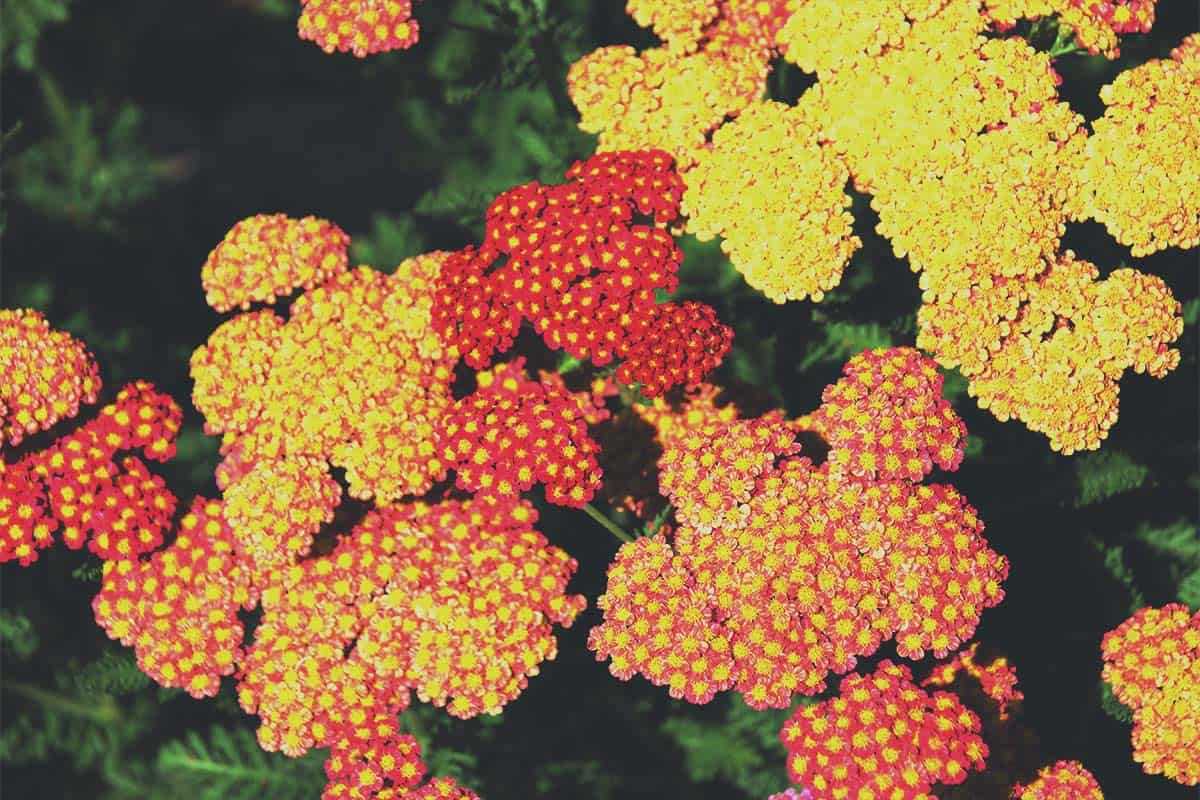
Yarrow is a versatile and beneficial herb to grow in your garden. Here are some of the key benefits of growing yarrow:
1. Medicinal Uses
- Yarrow has been used for centuries in traditional medicine for its medicinal properties.
- It is known for its anti-inflammatory and analgesic properties, which make it useful for relieving pain and reducing inflammation.
- Yarrow is also used to treat digestive issues, headaches, and cold symptoms.
2. Natural Pest Control
- Yarrow attracts beneficial insects such as ladybugs and lacewings, which prey on harmful garden pests like aphids and mites.
- Growing yarrow in your garden can help control pest populations and reduce the need for chemical insecticides.
3. Soil Improvement
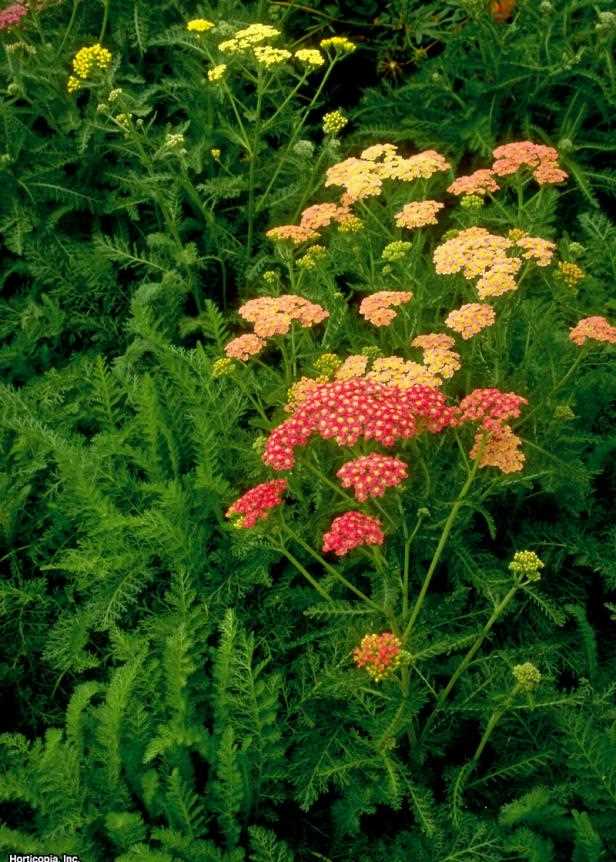
- Yarrow has deep roots that can penetrate compacted soils, improving soil structure and drainage.
- The plant’s roots also help break up hardpan and bring nutrients to the surface.
- When yarrow is grown as a cover crop, it can add organic matter to the soil when it is tilled under.
4. Attractive to Pollinators
- Yarrow produces clusters of small flowers that attract bees, butterflies, and other pollinators to your garden.
- Having yarrow in your garden can help support pollinator populations and promote biodiversity.
5. Drought Tolerant
- Yarrow is a drought-tolerant plant that can thrive in dry conditions.
- Its ability to withstand periods of low water makes it a great addition to water-wise or xeriscape gardens.
6. Cut Flower and Craft Material
- The flowers of yarrow can be cut and used in floral arrangements or dried for crafts.
- They retain their color and shape well and can be a beautiful addition to wreaths, potpourri, or dried flower arrangements.
With its many benefits, yarrow is a valuable addition to any garden. Whether you are looking for a medicinal herb, natural pest control, soil improvement, or simply an attractive and low-maintenance plant, yarrow has you covered.
How to Plant and Care for Yarrow
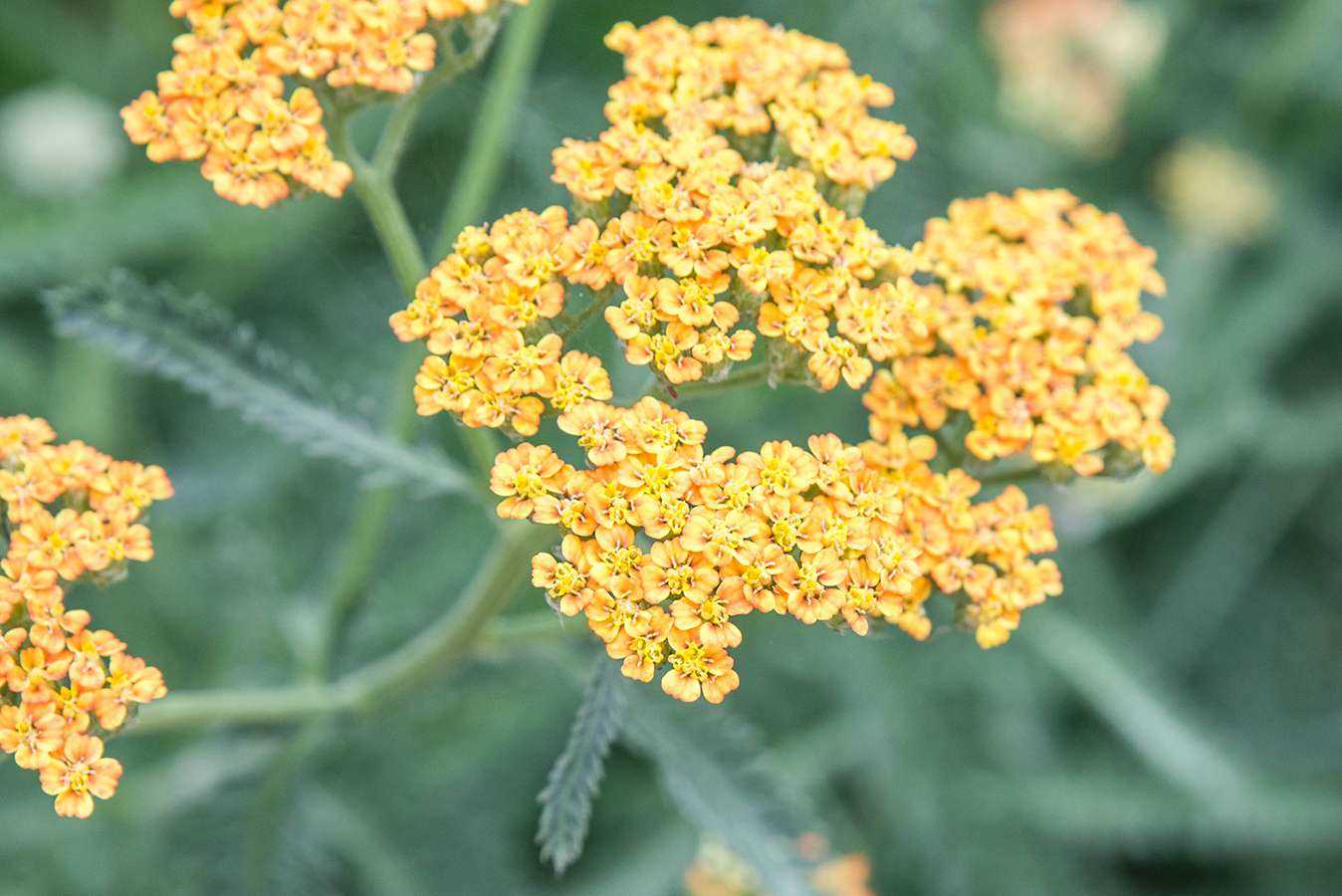
Planting Yarrow
Yarrow is a versatile and hardy plant that can be successfully grown in a variety of environments. Here are the steps to plant yarrow:
- Choose a location: Yarrow thrives in full sun, but it can tolerate some shade. Select a spot with well-draining soil.
- Prepare the soil: Loosen the soil with a garden fork or tiller to a depth of 8-12 inches. Remove any weeds or debris.
- Plant the yarrow: Dig a hole that is slightly larger than the root ball of the yarrow plant. Place the plant in the hole, ensuring that the crown is level with the soil surface. Backfill the hole with soil and gently tamp it down.
- Water the yarrow: Give the newly planted yarrow a thorough watering to help it settle into the soil. After the initial watering, yarrow is drought-tolerant and generally does not require much additional water.
Caring for Yarrow
Yarrow is a low-maintenance plant, but it still benefits from some care and attention. Here are some tips to keep your yarrow thriving:
- Watering: Once established, yarrow is quite drought-tolerant and only needs to be watered during prolonged dry spells. Overwatering can lead to root rot, so be cautious not to water too frequently.
- Fertilizing: Yarrow doesn’t require much fertilization. If you feel that your yarrow could use a nutrient boost, you can apply a balanced slow-release fertilizer in early spring.
- Pruning: Yarrow can become leggy and benefit from regular pruning. Cut back the stems after the flowers fade to encourage bushier growth and prevent self-seeding.
- Pest and disease control: Yarrow is generally resistant to common pests and diseases. However, occasional issues with aphids or powdery mildew may arise. Treat any problems promptly with an appropriate pesticide or fungicide.
Propagating Yarrow
Yarrow can be easily propagated through division or stem cuttings. Here’s how:
- Division: Dig up an established yarrow plant in early spring or fall. Carefully divide the plant into smaller clumps, making sure each division has a healthy root system. Replant the divisions immediately.
- Stem cuttings: Take stem cuttings from a healthy yarrow plant in early summer. Make a clean cut just below a node, and remove the lower leaves. Dip the cut end in rooting hormone and plant it in a pot filled with a well-draining soil mix. Keep the cuttings moist and warm until they develop roots.
| Planting | Caring | Propagation |
|---|---|---|
| Choose a sunny spot with well-draining soil. | Water sparingly once established and avoid overwatering. | Divide established plants in spring or fall or take stem cuttings in summer. |
| Prepare the soil by loosening it and removing weeds. | Prune after flowering to maintain compact growth. | Ensure each division or cutting has a healthy root system. |
| Plant yarrow at the same depth as the root ball. | Apply slow-release fertilizer sparingly in early spring. | Keep cuttings moist and warm until they root. |
Common Yarrow Species
Yarrow, scientifically known as Achillea millefolium, is a flowering plant native to temperate regions of the Northern Hemisphere. It belongs to the Asteraceae family and is a popular choice among gardeners for its beautiful flowers and numerous medicinal properties.
1. Achillea millefolium
Achillea millefolium is the most common species of yarrow. It is a hardy perennial plant that can grow up to 1 meter in height. This species is known for its feathery, fern-like leaves and clusters of small, white flowers. It blooms from late spring to early fall.
2. Achillea filipendulina
Achillea filipendulina, also known as fern-leaf yarrow, is another popular species of yarrow. It can grow up to 1.2 meters in height and has larger and deeply divided leaves compared to Achillea millefolium. The flowers of this species are golden yellow and form flat-topped clusters.
3. Achillea ptarmica
Achillea ptarmica, commonly known as sneezewort or white yarrow, is a species of yarrow that is native to Eurasia. It is a herbaceous perennial plant with white flowers that form dense clusters. This species can grow up to 1 meter in height and blooms from late spring to early summer.
4. Achillea tomentosa
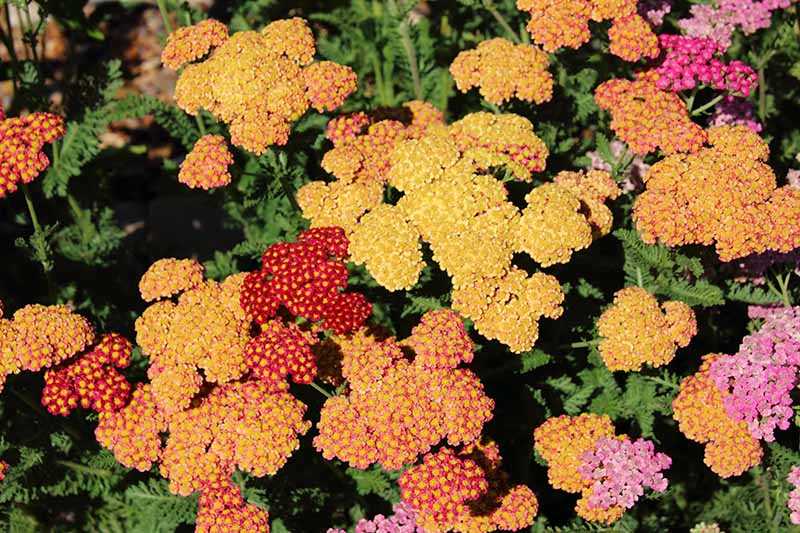
Achillea tomentosa, also known as woolly yarrow, is a low-growing species of yarrow that forms a dense mat of grey-green leaves. The flowers of this species are small and yellow and bloom in early summer. Achillea tomentosa is often used as a ground cover or in rock gardens.
5. Achillea nobilis
Achillea nobilis, commonly known as noble yarrow, is a species of yarrow that is native to the Alps and other mountainous regions of Europe. It can grow up to 50 centimeters in height and has white flowers with a yellow center. This species blooms from late spring to early summer.
6. Achillea clavennae
Achillea clavennae, also known as cudweed yarrow, is a species of yarrow that is native to Europe and Asia. It has small, white flowers that form dense clusters and bloom in early summer. This species is known for its medicinal properties and is often used in traditional herbal remedies.
7. Achillea ptarmicoides
Achillea ptarmicoides, commonly known as mountain yarrow, is a species of yarrow that is native to North America. It can grow up to 60 centimeters in height and has white flowers that form large, flat clusters. This species blooms from mid-summer to early fall.
8. Achillea ageratum
Achillea ageratum, also known as sweet yarrow, is a species of yarrow that is native to Europe and Asia. It can grow up to 90 centimeters in height and has pink or purplish flowers that form dense, rounded clusters. This species blooms from early summer to early fall.
9. Achillea borealis
Achillea borealis, commonly known as boreal yarrow, is a species of yarrow that is native to cold regions of North America, Europe, and Asia. It can grow up to 60 centimeters in height and has white or pink flowers that bloom in early summer. This species is adapted to cold climates and is often found in alpine regions.
10. Achillea asplenifolia
Achillea asplenifolia, also known as fern-leaf yarrow or cutleaf yarrow, is a species of yarrow that is native to Europe. It can grow up to 1 meter in height and has finely divided, fern-like leaves. The flowers of this species are white or pink and form dense clusters.
These are just a few examples of the common yarrow species. Yarrow is a versatile plant that comes in a variety of colors and sizes, making it a popular choice for gardeners and herbal enthusiasts.
Popular Yarrow Varieties
Yarrow is a versatile plant that comes in a variety of colors and forms. Here are some popular yarrow varieties to consider for your garden:
1. Achillea millefolium ‘Cerise Queen’
This yarrow variety features vibrant pink flowers that bloom from early to late summer. It grows to a height of 2-3 feet and makes a beautiful addition to flower beds and borders.
2. Achillea millefolium ‘Paprika’
‘Paprika’ is a yarrow variety with striking red-orange flowers that fade to a soft pink as they age. It has a compact growth habit and reaches a height of 1-2 feet, making it ideal for smaller gardens or containers.
3. Achillea millefolium ‘Moonshine’
‘Moonshine’ is a popular yarrow variety known for its bright yellow flowers and silvery-gray foliage. It stands out in the garden and pairs well with purple or blue flowering plants.
4. Achillea millefolium ‘Strawberry Seduction’
This yarrow variety has vibrant red flowers that bloom from early summer to fall. It is drought-tolerant and attracts butterflies and bees to the garden.
5. Achillea millefolium ‘Coronation Gold’
‘Coronation Gold’ is a classic yarrow variety with golden yellow flower heads. It is a vigorous grower that can reach a height of 3-4 feet, making it a good choice for adding vertical interest to the garden.
These are just a few examples of the many yarrow varieties available. Consider your garden’s color scheme, size, and growing conditions when choosing the right yarrow variety for you.
Harvesting and Using Yarrow
Yarrow is a versatile herb that can be harvested and used in various ways. Here are some tips on how to harvest and utilize yarrow:
Harvesting Yarrow
- Yarrow can be harvested when the flowers are in full bloom. This is usually around mid-summer.
- Cut the flower heads using a sharp pair of scissors or pruners. Be sure to leave some stems and foliage behind for the plant to continue growing.
- Harvesting in the morning, after the dew has dried, is ideal as the plant’s essential oils are at their highest concentration at this time.
- It’s important to harvest yarrow from areas that are free from pesticides and pollutants.
Drying Yarrow
- After harvesting, gather the yarrow stems and tie them into small bundles.
- Hang the bundles upside down in a well-ventilated area away from direct sunlight.
- Allow the yarrow bundles to dry completely, which may take a few weeks.
- Once dry, remove the dried flower heads from the stems and store them in airtight containers.
Using Yarrow
Yarrow has numerous uses and can be utilized in the following ways:
- Medicinal Purposes: Yarrow has been used for centuries in herbal medicine. It can be made into teas, tinctures, or salves to treat various ailments such as colds, fevers, and digestive issues. However, it’s important to consult with a healthcare professional before using yarrow for medicinal purposes.
- Culinary Uses: Yarrow leaves and flowers can be used in salads or as a garnish. They have a slightly bitter taste and can add a unique flavor to dishes.
- Insect Repellent: Yarrow has natural insect-repellent properties. You can create a spray or infuse yarrow into oils to repel mosquitoes and other insects.
- Composting: Yarrow leaves and flowers can be added to compost piles to enrich the soil with nutrients.
- Decorative Purposes: Dried yarrow flowers can be used in floral arrangements and crafts.
Yarrow is a versatile herb that can be easily harvested and utilized in various ways. Whether for medicinal purposes, culinary uses, or as a natural insect repellent, yarrow offers a range of benefits to enhance your garden and well-being.
Tips for Growing Yarrow Successfully
Growing yarrow successfully requires some attention to detail and care. Here are some tips to help you cultivate healthy yarrow plants:
1. Choose the Right Location
Yarrow thrives in full sun but can tolerate some shade. It prefers well-draining soil and can tolerate a wide range of soil types. Make sure to choose a location with good air circulation to prevent disease.
2. Prepare the Soil
Before planting yarrow, prepare the soil by removing any weeds and loosening it with a garden fork or tiller. Add organic matter, such as compost or aged manure, to improve soil fertility and drainage.
3. Planting
Yarrow can be planted from seeds or transplants. If planting from seeds, sprinkle them on the soil surface and lightly press them into the soil. For transplanting, dig a hole slightly larger than the root ball and place the yarrow plant in the hole, ensuring that the root crown is level with or slightly above the soil surface.
4. Watering
Yarrow is drought-tolerant once established but will benefit from regular watering during dry periods. Water yarrow plants deeply, allowing the soil to dry out between waterings. Avoid overwatering, as yarrow can be prone to root rot in waterlogged soil.
5. Mulching
Apply a layer of organic mulch, such as straw or shredded bark, around the base of yarrow plants. Mulching helps to retain moisture, suppress weeds, and regulate soil temperature.
6. Pruning
Deadhead yarrow flowers regularly to promote additional blooms. Cut the flower stalks down to the base of the plant after they have finished blooming. In late winter or early spring, cut back the entire yarrow plant to a height of 4-6 inches to encourage new growth.
7. Pest and Disease Control
Yarrow is relatively resistant to pests and diseases. However, it can be occasionally affected by aphids, spider mites, and powdery mildew. Monitor your plants regularly and take appropriate action if pest or disease problems arise.
By following these tips, you can successfully grow yarrow in your garden. Enjoy the beautiful flowers and aromatic foliage of this versatile and easy-to-grow perennial!
Questions and Answers:
What are the properties of yarrow?
Yarrow has many properties, including anti-inflammatory, antimicrobial, antiseptic, and astringent properties. It is also known for its ability to stop bleeding and reduce fever.
How do I plant yarrow?
To plant yarrow, choose a sunny location with well-drained soil. Sow the seeds directly into the soil in the spring or fall. Make sure to keep the soil moist until the seeds germinate. You can also propagate yarrow by dividing the root clumps in the spring.
What care does yarrow require?
Yarrow is a low-maintenance plant that requires minimal care. It prefers well-drained soil and does not need frequent watering. However, it does benefit from occasional fertilizing with a balanced fertilizer. Deadheading the flowers to encourage more blooms is also recommended.
What are the different species and varieties of yarrow?
There are several species of yarrow, including Achillea millefolium, Achillea filipendulina, and Achillea ptarmica. Each species has different varieties with varying flower colors, heights, and foliage. Some popular varieties include ‘Moonshine’, ‘Paprika’, and ‘Coronation Gold’.
Can yarrow be used for medicinal purposes?
Yes, yarrow has been used for centuries for its medicinal properties. It can be used to treat conditions such as wounds, digestive issues, and menstrual problems. However, it is important to consult with a healthcare professional before using yarrow for medicinal purposes.
How do I prune yarrow?
To prune yarrow, simply cut back the stems after the plant has finished blooming. This will help promote new growth and prevent the plant from becoming too leggy. You can also deadhead the flowers throughout the blooming season to encourage more blooms.
Does yarrow attract pollinators?
Yes, yarrow is known to attract pollinators such as bees and butterflies. The flat clusters of small flowers provide a landing platform for these insects, making it easy for them to access the nectar.







